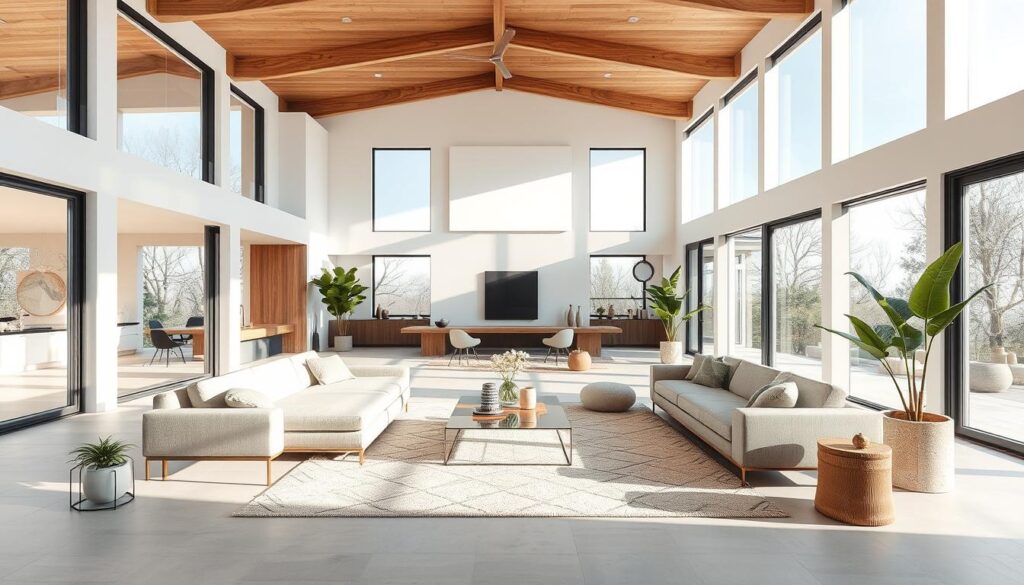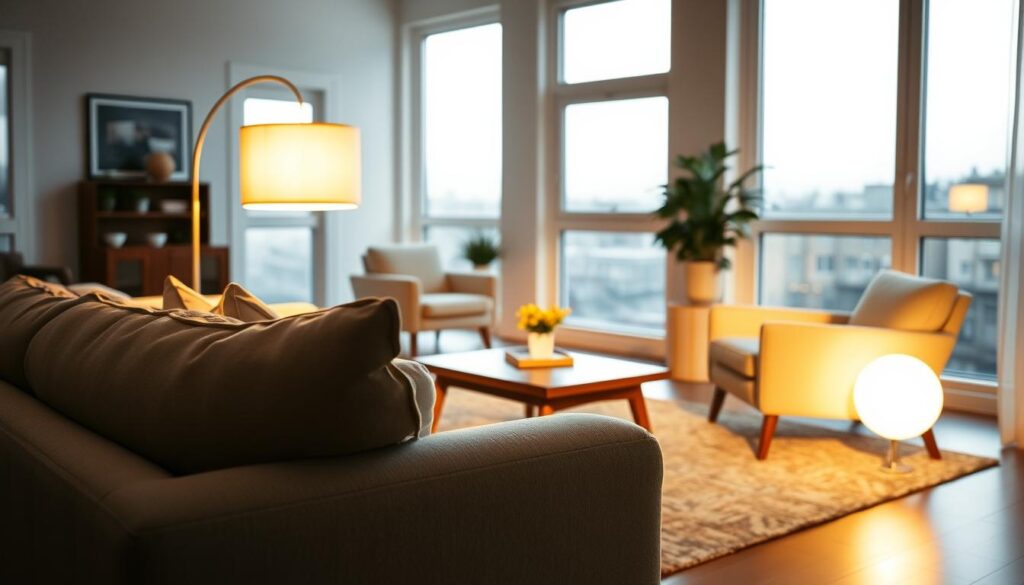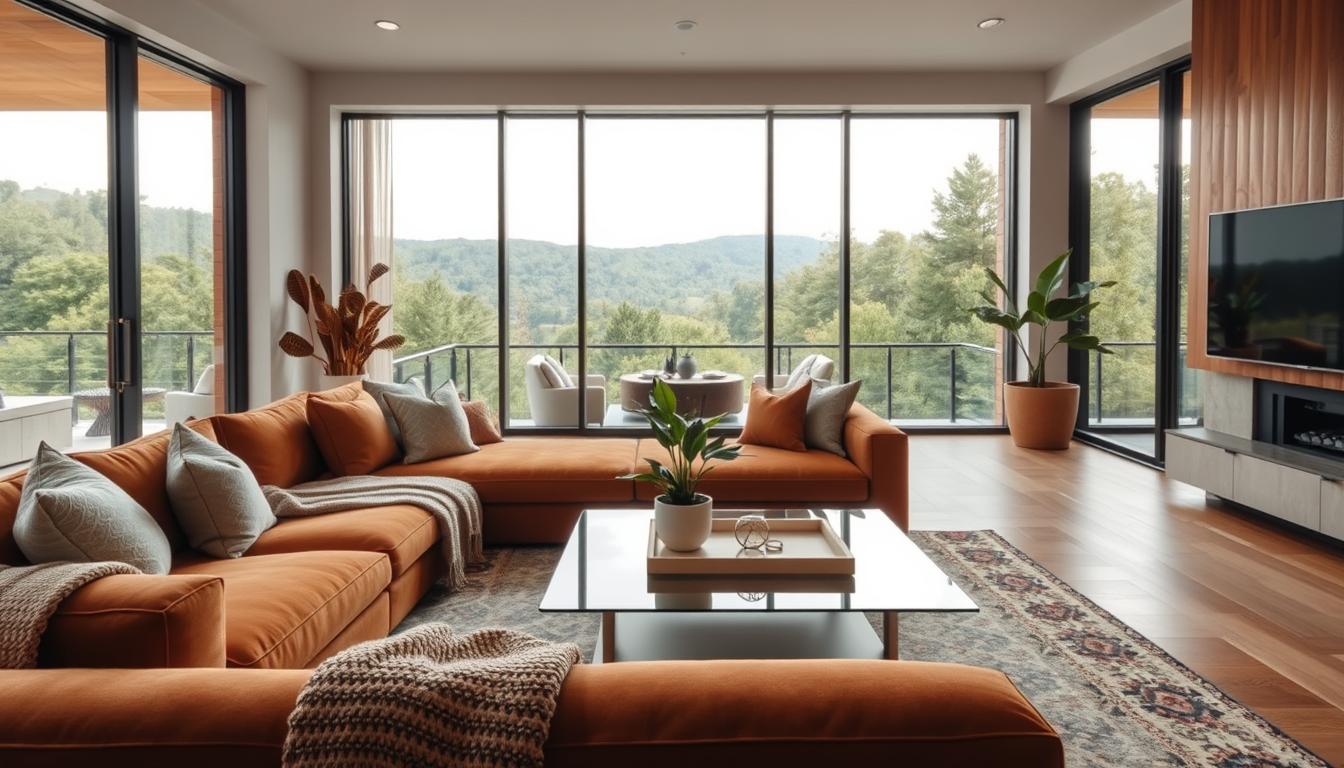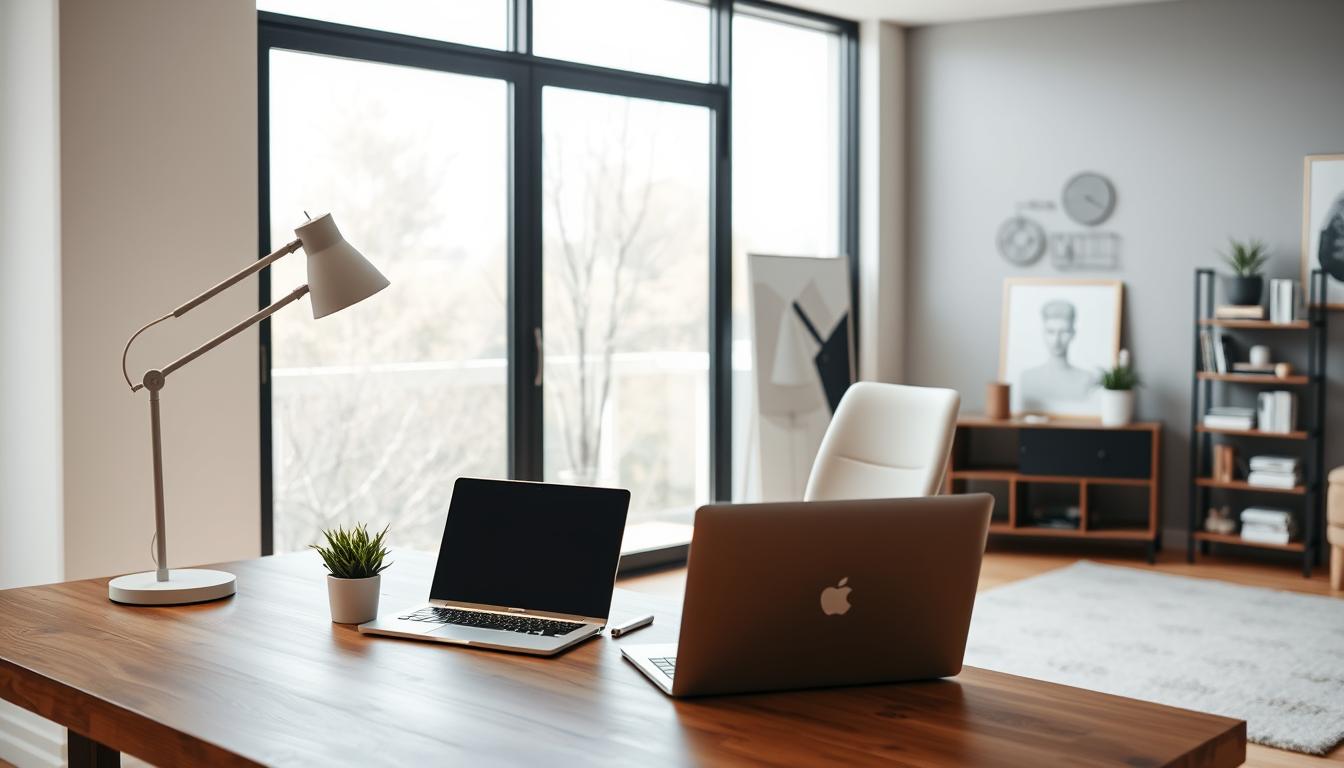A well-designed living space can change our daily lives a lot. Studies show that a stylish interior can make us happier, more productive, and healthier. It’s key to make our homes reflect who we are.
At Estilo Lepa, we know how important it is to make your home a place of peace and energy. Our top design ideas will help you make a space that is both beautiful and useful for you.
Key Takeaways
- Discover the latest trends in stylish interior designs
- Learn how to create a functional and beautiful living space
- Explore our top picks for home decor inspiration
- Get expert tips on transforming your living room and bedroom
- Find out how to incorporate texture and color into your design
Exploring the Latest Interior Design Trends
The world of interior design is always changing, with new trends popping up every season. It’s exciting to see how these trends can turn modern homes into cozy and stylish places.
Bold colors are a big part of today’s interior design. Incorporating bold colors can make a room feel more alive and energetic. As Wassily Kandinsky said, “Color is a power which directly influences the soul.”
“Color is a power which directly influences the soul.” – Wassily Kandinsky
Incorporating Bold Colors
To add bold colors to your home, start with small things like throw pillows or rugs. For example, a deep blue wall can make a living room feel more sophisticated. It’s important to mix bold colors with neutral ones to keep the space balanced.
Natural Elements in Home Decor
Using natural elements in home decor is also a big trend. It brings a sense of calm and connects us to nature. You can add plants, use natural materials, or include wood and stone in your design.
A wooden coffee table can warm up a room, and a vase with fresh branches adds elegance. As we keep exploring creative home decorating ideas, natural elements are becoming more popular.
Minimalism Meets Functionality
Minimalism is all about simplicity and function. It’s not just about having fewer things; it’s about creating a space that looks good and works well. This means choosing furniture that does more than one thing and keeping things tidy.
Minimalism makes rooms feel bigger and more peaceful. As we look ahead, the mix of minimalism and function will keep shaping contemporary design trends.
How to Choose the Right Color Palette
A good color palette is key to a great interior design. It sets the mood and function of your space. When we think of home decor inspiration, color is usually the first thing we consider.
Colors can make us feel certain ways and set the mood. Knowing how colors affect us is important for good design choices.
Understanding Color Psychology
Color psychology studies how colors affect our feelings and actions. For example, blue makes us feel calm, while red energizes us. Choosing colors should match the mood we want in our home.
Here’s a simple table showing how different colors make us feel:
| Color | Emotional Impact |
|---|---|
| Blue | Calmness, Serenity |
| Red | Energy, Passion |
| Green | Balance, Harmony |
| Yellow | Happiness, Optimism |
Tips for Harmonizing Colors
Making colors work together is an art. Here are some room makeover tips for a balanced color palette:
- Choose a main color and one or two accent colors.
- Follow the 60-30-10 rule: 60% main color, 30% secondary, and 10% accent.
- Use different shades of one color for a single-color look.
For interior design inspiration, look to nature, art, or your favorite clothes. These can give you great color ideas.
The Role of Accent Colors
Accent colors add personality and depth. Use them in small ways, like throw pillows or rugs. The goal is to pick colors that match your main color, creating a unified look.
By understanding color psychology, mixing colors well, and using accent colors wisely, we can make a color palette that inspires and improves our living space.
Maximizing Small Spaces with Smart Design
Small spaces need smart solutions for a functional and stylish home. It’s key to use every inch wisely.
Multi-functional furniture is a great way to make small spaces work better. For example, a storage ottoman can be a seat and a place to store things. A murphy bed can turn a bedroom into a living area during the day.
Multi-Functional Furniture Options
Choosing multi-functional furniture is smart for creative home decorating. Look for a coffee table with storage or a desk that folds against the wall. These items save space and help keep things tidy.
- Nesting tables that can be stacked when not in use
- Sofa beds for accommodating guests
- Wall-mounted shelves for additional storage
Creative Storage Solutions
Good storage is key in small spaces. Creative storage solutions can greatly help keep your home neat. For more ideas, see our guide on tiny home interior design.
Using vertical space with tall shelves or units keeps floors clear. Under-bed storage boxes and hidden spots in furniture also offer lots of storage.
Creating an Open Floor Plan
Creating an open floor plan is more than just removing walls. It’s about making your living space seamless and beautiful.
Open floor plans are popular because they make homes feel bigger and more open. They remove barriers, creating a space that’s perfect for socializing and enjoying the airiness.
Benefits of Open Spaces
Open floor plans make your home feel bigger and more welcoming. They remove the feeling of being in separate rooms. This design is great for families and those who love to entertain.
Key advantages of open floor plans include:
- Increased natural light distribution
- Improved social interaction
- Enhanced flexibility in furniture arrangement
To see how open floor plans differ, let’s compare them to traditional layouts:
| Feature | Traditional Layout | Open Floor Plan |
|---|---|---|
| Natural Light | Limited to individual rooms | Distributed across the open area |
| Social Interaction | Restricted by room divisions | Encourages interaction across spaces |
| Furniture Arrangement | Limited by room size and shape | Offers more flexibility |
Tips for Seamless Transitions
To make an open floor plan work, design is key. Using the same flooring material everywhere helps create a smooth flow. It ties the different areas together visually.

Choosing a color scheme that works well with your design is also important. A cohesive color palette helps keep the space open while hinting at different areas.
By following these tips, you can enjoy the benefits of an open floor plan. Your home will be stylish, functional, and reflect the latest design trends.
Incorporating Textures for Visual Interest
Textures are key in interior design, adding depth and beauty to a room. Mixing different textures makes a space both beautiful and engaging.
Layering Fabrics and Materials
Layering fabrics and materials is a great way to add texture. For example, smooth leather with chunky knits or velvet with linen creates a cozy feel. This method is a cornerstone of creative home decorating, making spaces unique and lively.
The Importance of Patterns
Patterns also bring texture and interest to a room. Combining stripes with florals or geometric shapes with abstract designs adds complexity. But, it’s important to balance patterns with solid colors to keep the space from feeling too busy. This balance is crucial for home decor inspiration that’s both stylish and comfortable.
By carefully choosing textures and patterns, we can make our homes more personal and enjoyable. It’s a way to reflect our style and make our living spaces more welcoming.
The Impact of Lighting on Interior Design
Lighting is more than just a need; it’s an art that can transform any space. It plays a key role in making a room feel inviting and look amazing.

Natural Light vs. Artificial Lighting
The mix of natural and artificial light is vital in lighting design. Natural light makes rooms feel bigger and is good for us. But, it’s not always enough, so artificial lighting is needed too.
Experts say the right mix of natural and artificial light can make a room feel special. We should think about how our rooms face and where windows are to get more natural light. For artificial light, we have many options like LED bulbs, floor lamps, and overhead lights.
“Lighting is the jewelry of architecture.” – Patrick Henry Bruce
Ways to Enhance Lighting Features
To make our home’s lighting better, we can try a few things. Using different light sources like ambient, task, and accent lighting can make a room interesting and useful. We can also use dimmers to change the light levels for different times or activities.
- Use mirrors to reflect natural light and make the room brighter.
- Install skylights or larger windows to increase natural light intake.
- Select light fixtures that are both functional and aesthetically pleasing.
Choosing the Right Fixtures
Picking the right lighting fixtures is key for our design goals. We should think about our space’s style, what we’ll do there, and the lighting we need. For more tips, check out John Cullen Lighting for expert advice.
By planning our lighting well, we can make spaces that are not just pretty but also useful and cozy. Whether we’re redoing a room makeover or a whole home renovation, lighting is a big part of our design.
Personalizing Your Space with Art and Decor
Art and decor are more than just accessories. They make a house truly yours. Choosing the right pieces can make your home feel more welcoming. We’ll look at how to pick art that speaks to you and find unique decor that adds character.
Selecting Art that Resonates with You
When picking art, choose pieces that mean something to you. This could be a painting that reminds you of a memory or a sculpture that shows your style. Think about the emotions you want to feel in your space.
Here are some tips for picking art:
- Choose pieces that reflect your style or interests
- Consider the color and how it fits with your decor
- Think about the emotions or moods you want to create
Sourcing Unique Decor Items
You can find unique decor in many places, like local markets or online vintage shops. Thrift stores and estate sales are also great for finding one-of-a-kind items. Think about the texture, color, and look you want to achieve.
Here are some ideas for finding unique decor:
- Visit local artisan markets for handmade decor
- Explore online vintage shops for rare finds
- Check thrift stores and estate sales for unique pieces
By adding art and decor that speaks to you, you can make your home truly yours. Whether you’re looking for home decor inspiration or tips on creative home decorating, the most important thing is to have fun and stay true to your style.
Sustainable Interior Design Practices
Interior design is evolving, with a focus on sustainability. This change is due to growing environmental awareness. Sustainable design aims to make homes beautiful and functional, using eco-friendly materials.
There are many ways to make interior design sustainable. Choosing materials that are good for the environment is key. This includes recycled, recyclable, or sustainably sourced materials.
Eco-Friendly Materials to Consider
There are many eco-friendly materials to choose from. Some popular ones are:
- Reclaimed wood, which adds history and reduces waste.
- Bamboo, known for its fast growth and sustainability.
- Low-VOC paints, which improve air quality.
- Recycled glass countertops, a durable and eco-friendly option.
| Material | Eco-Friendly Features | Application |
|---|---|---|
| Reclaimed Wood | Reduces waste, unique aesthetic | Furniture, flooring |
| Bamboo | Fast growth rate, sustainable | Flooring, furniture |
| Low-VOC Paints | Improves indoor air quality | Walls, ceilings |
Energy-Efficient Solutions for Homes
Energy efficiency is crucial in sustainable design. It helps reduce energy use and lower bills.
Effective energy-saving solutions include:
- LED lighting, which uses less energy and lasts longer.
- Smart thermostats, which adjust heating and cooling based on use.
- Energy-efficient appliances, which use less energy without losing performance.
By adopting sustainable design, we can make homes that are both beautiful and green. As we follow contemporary design trends and home renovation ideas, let’s remember to choose sustainable options.
Designing Functional Outdoor Spaces
The art of designing outdoor spaces is about mixing function with beauty. It creates an extension of our homes that looks great and works well.
When we think about interior home design ideas, we should also think about the outdoors. A well-designed outdoor area can make our homes more livable and fun.
Best Practices for Outdoor Living Areas
To make an outdoor living area inviting, we need to focus on a few key things. First, it should be comfy, with good seating and shade. Second, it should be useful, with things like outdoor kitchens or fire pits that bring people together.
Adding stylish interior designs to our outdoor spaces can also make them more appealing. We can do this by picking furniture and decor that match our indoor style. This makes the transition from inside to outside smooth.
- Choose durable, weather-resistant materials for furniture and decor.
- Think about the layout to make sure it’s good for talking and moving around.
- Add lighting to make the space usable in the evening.
Essential Garden Design Tips
For garden design, creative home decorating ideas are key. Picking the right plants, understanding texture and color, and adding hardscaping elements are all important.
A well-designed garden adds beauty to our outdoor space and improves our home’s feel. By planning our garden carefully, we can create a peaceful oasis that matches our indoor areas.
- Pick plants that fit your climate and the sunlight your garden gets.
- Use a mix of textures and colors to add depth and interest.
- Add hardscaping like paths, patios, and walls to make it more functional.
Embracing Vintage and Retro Styles
Adding vintage and retro styles to your home can make it unique. It lets you show off your personality and style. We’ll look at how to mix old and new and where to find vintage items for your space.
Mixing Old and New Elements
Mixing vintage and modern pieces can be tricky. Start with a few vintage items, like an antique chair or rug. Then, add modern furniture and decor to balance it out. This mix creates a lively and interesting space.
For more ideas, check out Decorilla’s retro interior design page.
When combining old and new, think about size and scale. Make sure vintage items aren’t too big or too small for modern pieces. A common color or texture can help tie everything together.
Finding Vintage Pieces
Finding the right vintage items can be exciting. Look in local thrift stores, antique shops, and flea markets. These places have unique items that can add charm to your home. Online marketplaces and vintage websites also have rare finds.
When looking for vintage items, check their condition and authenticity. Think about how they fit with your design. You can also refinish or repurpose items to make them work for you today.
By embracing vintage and retro, you can make your home truly special. With these tips, you’re ready to start your journey in vintage and retro interior design.
Final Tips for Successful Interior Design Projects
As we wrap up our look at interior design, remember a few key things. A successful project needs careful planning, a clear budget, and the ability to adjust your design. By using modern design trends and renovation ideas, you can make a space that looks great and works well.
Effective Planning and Budgeting
To reach your design goals, start with a realistic budget and timeline. Think about materials, labor costs, and any permits you might need. Good planning helps avoid surprises and keeps your project on schedule.
Flexibility in Design
Being open to changes during design can make your project better. Whether it’s finding new materials or adjusting your design for unexpected issues, being flexible is crucial. This way, you can create a space that matches your vision and stays up-to-date with the latest design ideas.


